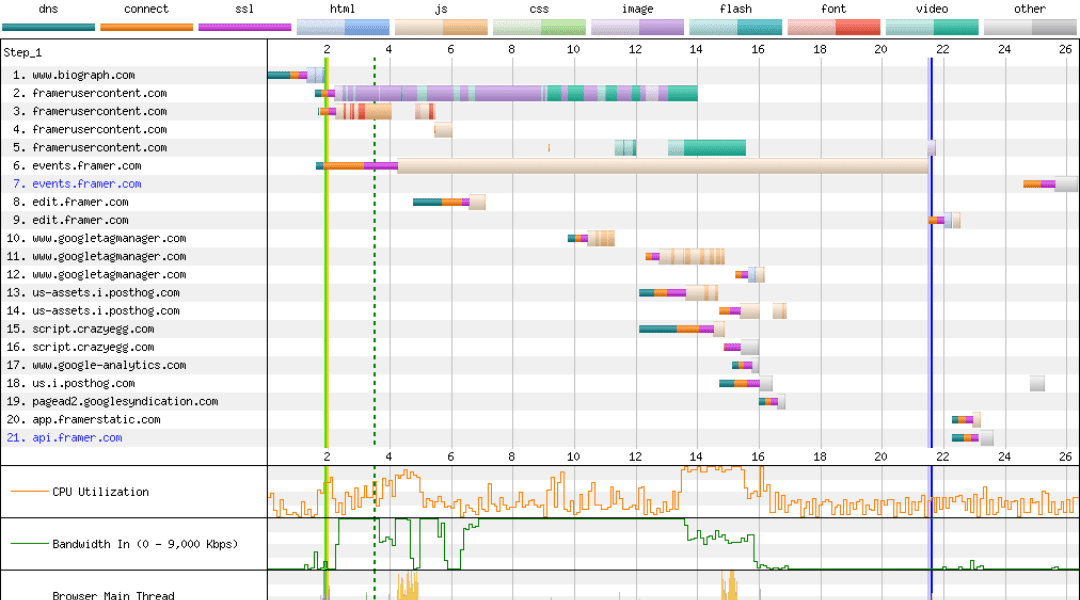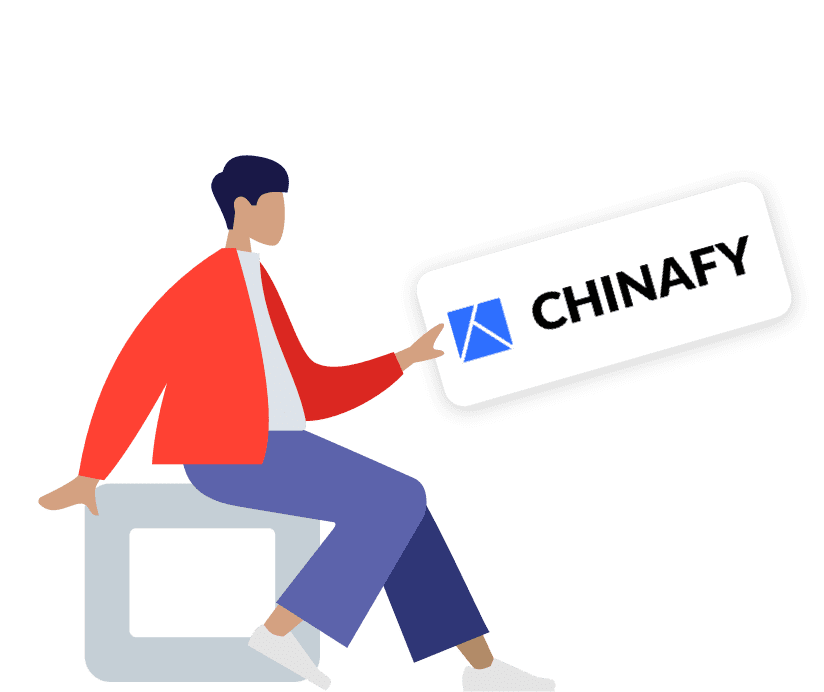1 - Expected post-Chinafy results
Does Framer work in China?
Web designers and developers all over the world use Framer to build websites via its no-code platform. But if your target audience includes China, it’s worth testing your site’s performance as Framer sites can frequently run into performance issues when accessed there.
TL;DR: Framer is a no-code/low-code platform for designers and developers to build interactive websites with ease. Websites built with Framer often face performance issues in mainland China due to default limitations of global CDNs and blocked/slow-performing third-party resources. These challenges can lead to slow load times, broken components, and a subpar user experience for Chinese visitors. You can, however, optimize Framer sites for China by leveraging tools like Chinafy that resolve incompatibilities without impacting your existing site.
In this guide, you’ll see what happens when you try to load a Framer site in Mainland China and ways to improve performance.
What is Framer and how does it work?
Framer is a no-code/low-code web design platform that allows users to create responsive, interactive websites without extensive coding knowledge. It works by providing a visual canvas with drag-and-drop functionality, so users can create components, and set up interactions without needing to code themselves.
Framer uses React to allow developers to integrate interactive components and features.
Framer also uses CloudFront as its default content delivery network (CDN) to optimize content delivery all over the world.
What affects Framer performance in China?
Here are a few of the factors that can impact the performance of Framer websites in Mainland China:
Content Delivery Networks (CDNs)
Framer relies on Amazon AWS Global as its content delivery network (CDN).
AWS CloudFront Global has a global edge network that does not include Points of Presence (PoPs) inside mainland China by default. As AWS China operates independently from AWS Global, Framer does not currently provide this as a hosting or CDN option.
Note: CloudFront customers with origins outside of China using the CloudFront global network may experience up to 70% more latency for their end-viewers in mainland China than customers using AWS China with China origins, Chinafy, or Chinafy with CloudFront global network.
JavaScript execution
Framer sites, being the interactive, no-code sites that they are, are typically dependent on JavaScript for rendering their interactive components. Slower network speeds and restrictions on certain resources in China can impact JavaScript execution, leading to delayed or failed rendering of site elements.
Other third-party integrations
Many Framer sites naturally incorporate third-party resources such as Google Fonts, Vimeo videos, or Google Analytics for modular functionality and customizability. However, like many other third party resources from platform supported resources to plugins, these services are often blocked, restricted, or slow to load from China, resulting in missing fonts, broken media, or non-functional analytics among other functionality issues.
What happens when you try to load a Framer site in China?
Testing Framer websites from within China reveals several common issues found on websites built by other CMS platforms including:
Slow loading times of 15+ seconds
Occasionally timing out
Broken images and videos
Missing fonts
Incomplete page rendering
To illustrate this, we tested a Framer site, www.biograph.com, a health clinic website in the US and China to compare web performance. Here are the results:
www.biograph.com web performance metrics for California, US:
Time to First Byte (content starts downloading): 0.789s
First Contentful Paint (text and images start appearing): 1.034s
Largest Contentful Paint (largest visible content finished loading): 2.329s
Visually complete: 4.5s
Fully loaded: 16.0s
The Biograph site uses a few large, high-quality images on their website which take some time to download, even from the US. The largest image (2,408KB file size) took 9615ms to completely download, for example.
When it comes to China, what often happens is that the accumulation of several slow-loading resources leads to far slower loading times overall. In this case, Biograph’s site took around 2 seconds longer to visually load in Beijing compared to California. This may not sound significant, but when the user’s expectation is that the page will completely load in 2 seconds or less, this additional wait time can impact perception of your brand and could cause some users to bounce.
Let’s see how Biograph’s site performance in Beijing compares to the US…
www.biograph.com web performance metrics for Beijing, China:
Time to First Byte (content starts downloading): 1.706s (compared to 0.789s in US)
First Contentful Paint (text and images start appearing): 1.941s (compared to 1.034s)
Largest Contentful Paint (largest visible content finished loading): 3.679s (compared to 2.329s)
Visually complete: 6.5s (compared to 4.5s)
Fully loaded: 19.5s (compared to 16.0s)
From this run below, you can see how content hosted on URLs framerusercontent.com events.framer.com is delaying the load time and likely impacting user experience on the page for users in Beijing, China. This may be caused by the infrastructure – i.e. Framer uses a CDN with limited PoPs near to China – or other factors like image size that can cause delays or broken components.

webpagetest.org
Note: To conduct these tests, we submitted www.biograph.com to webpagetest.org, testing web performance in LA, California and Beijing, China, using an iPhone 15 on a 4G network.
How to make Framer sites work better in China
There are various factors that come into the decisions involved with making a website run optimally in China, including whether your main target audience is based in China and how much time, money and resources you can afford to devote to the project.
For businesses looking to get their website working fast and fully in China without changing their existing website or rebuilding a site specifically for China, here are some options you can consider:
Use Chinafy as a complete solution
Keep your existing website exactly as it is and we’ll generate a China-friendly version with all optimizations applied for you.
Here’s how Chinafy works:
Generates a version of your website for China visitors without affecting your current site.
Identifies and remediates blocked or slow resources, such as replacing Google Maps with Baidu Maps where needed, as well as a range of remediation options.
Adds a China-friendly CDN without changing your current hosting set-up.
If you’re hosting offshore, Chinafy routes China-IP-based traffic to the China-optimized version of your site without impacting global traffic which will still see your existing site. If you’re already hosting onshore, all your traffic will see the optimized version for China visitors.
Chinafy then keeps your China-optimized site in sync with your global one, so that any changes to content are reflected accordingly.
Other manual web performance optimizations
Use China-friendly or self-hosted fonts - if you’re currently relying on Google Fonts or other blocked/restricted font services, you could host fonts locally or use system fonts that are widely supported.
Read more about how to fix font loading issues in China
Optimize asset hosting - if you’re using lots of assets that are hosted on Framer domains, you could consider self-hosting these resources to reduce load times if you have the means to do so (e.g., using a more China-friendly CDN).
Replace or avoid blocked third-party tools - You may wish to remove any obvious third-party culprits for loading issues, like Google APIs or Western social media plugins like Instagram. Unfortunately, there are hundreds, if not thousands, of resources that have incompatibility issues (meaning they may take a long time to load or fail to load at all) in China and the way they work differs and evolves over time so there is no one-off list or means to edit these resources. Changes will likely have to be made on an ongoing basis.
Regularly test site performance - continuously monitor your website's performance using tools, like Chinafy’s Global Speed test or webpagetest.org, to identify and address issues promptly.
In summary, Framer’s default configurations may not be optimal for users in mainland China, with performance issues stemming from both infrastructure and code-based incompatibilities. That’s not to say that Framer works cannot work well in China.
By implementing targeted optimizations and leveraging specialized tools like Chinafy, businesses can significantly improve the accessibility and efficiency of their Framer sites for Chinese audiences, sometimes even more so than their existing global site performance.
Chinafy specializes in making websites load fast and fully for the Chinese market. Contact us to learn how we can help make your Framer site China-ready with minimal effort on your side.



1 - Expected post-Chinafy results






























